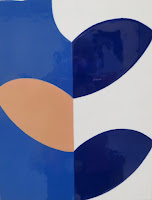Like all the titles of Venice’s Biennale curated shows, this one was designed to permit anything to be included. I was drawn to many of the objects.
The striking black and white images by South African Zanele Muholi (b. 1972 Durban, South Africa) of herself in various elaborate garments and headdresses made from unlikely everyday materials had impressed me at the Museum of Contemporary Art in Cape Town last year. Here they were blown up to enormous size, like JR’s images, but not like his work at all.
Near the exhibition entrance was a series of photographs by Soham Gupta (b. 1988 Kolkata, India) of street people in India, heart wrenchingly charming and loving. The photographs show the humanity of people we usually avoid looking at and therefore seeing.

Unfortunately, these images were accompanied by the sounds of Christian Marclay’s (b. USA 1955, lives London) contribution, simultaneously projecting 48 war movies overlapped, with all their soundtracks playing at once, the sound of chaos and fighting booming from the room where the video is on view. Making separate spaces for different artists resulted in more bleed from one artist’s display to the other’s than I remember in previous Arsenale installations.
 |
| Christian Marclay, 48 War Movies, 2019, video |
Very traditional, reminiscent of John Chamberlain but more evidently carefully constructed, I liked the large sculptures by Carol Bove (b. Geneva 1971, lives New York City), twisted interlocked forms with smooth surfaces and gentle colors (the catalogue calls them candy-colored). One must walk around them to see them and some have surprises on the other side.

There were quite a few very large sculptures. Yin Xiuzhen (b. 1963, lives and works in Beijing) for example, created a huge pair of tires with metal connectors, suspended above the floor, next to Trojan, a gigantic image of a person bent over in an airplane seat in emergency landing mode. Her sculpture is hollow, presumably like the Trojan Horse.
Sun Yuan and Peng Yu had a chair with metal tubes that occasionally sprang to life, propelled by forced air, and Can’t Help Myself, 2016, the huge trapped painting machine that was on view a while ago at the Guggenheim. The first is pretty obvious, the second is actually touching, as the machine alternately clears and spatters paint and thrusts its ‘arm’ into the air as if in desperation. While a New York Times reviewer complained that most of the artists in this exhibition had already been seen in New York, he seemed to forget that there may be more people attending the biennale than New York art experts who have attended every gallery and museum there.
Speaking of artists who have been seen in New York, I was pleased to see work by Jimmie Durham (b. USA 1940, lives in Berlin), an artist I first saw decades ago, who virtually disappeared into Germany, and now is becoming visible everywhere, including a retrospective at the Whitney last year. He created European wild animals from skulls, metal tubing, an armoire, and clothes. Like the mechanical paint brush, the works are amusing and touching at the same time, evoking their models with a sense of how they might be envisioned after they have gone extinct.
 |
Ulrike Műller (b. 1971 Austria, lives in New York City) exhibited both rugs and paintings with her tight abstract designs. I loved that Rug (con tacones), a rug depicting what would walk on it, was hand woven in the workshop of Jeronimo and Josefina Hernandez Ruiz, Teotitlán del Valle, Oaxaca. This is a huge traditional rug-weaving center in Mexico. Her smaller abstract paintings seemed oddly traditional to me, but lovely. I could not see the critique of hierarchies, feminist or queer content attributed to her work in the label and catalog. Somehow the compositions of the smaller paintings are compelling.
 |
| Bleached Reef |
 |
| Toxic Reef |
 |
| Toxic Reef, detail |
 |
| Toxic Reef, artists |
Another work suggesting disappearing resources, but lovely as an object is Otobang Nkanga’s (b. 1974 Nigeria, lives in Antwerp) Veins Aligned, made of marble, glass and paint and snaking along the axis of a large room. It suggests a river and only as you reach the end, 26 meters away, do you see that it changes from lovely blue to a fierce red, suggesting contamination and pollution.
Anthony Hernandez’s (b. 1947 Los Angeles, lives in L. A. and Idaho) photographs of contemporary unfinished and failed projects in Rome may challenge the wastefulness of urban renewal but they are often beautifully composed images that abstract the structures.
And Tavares Strachan’s (b. 1979 Nassau, lives in New York and Nassau) neon text, Robert, 2018, shocked and distressed me as many of the more vocal videos did not.
Market, by Zhanno Kadyrova (b. 1981 Brovery, Ukraine, lives in Kyiv) near the end of the curated show, amused us as a ceramic tile, cement, mirror and stone recreation of an outdoor market, and was a good installation to lead us into lunch.











No comments:
Post a Comment